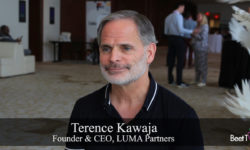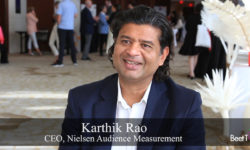MARCO ISLAND, FL — Roku doesn’t want to throw out traditional-length TV ads or measurement – it just thinks creative disruption and alternative approaches can add far more effectiveness and insight.
Together with MAGNA Media Trial, the TV platform just published Beyond the :30 on Streaming TV, a research piece that found new video ad formats in streaming TV are twice as favorable as traditional TV ads for consumers.
In this video interview with Mike Shields for Beet.TV, Alison Levin, VP, Ad Sales & Strategy, Roku, explains what’s changing in TV ad land.
Format figures
“It’s no surprise that, when you do something that’s more integrated, more personalized, it performs much better than a traditional 15- or 30-second spot,” Levin says.
The study looked at three formats used on Roku, reporting:
- Thematic Tagged Vignettes catch attention: 65% of respondents agreed that the spots “taught me something new,” besting traditional spots by some 20 points.
- Roku Original Vignettes triple return on purchase intent: +10% purchase intent for Roku Originals Vignettes vs +3% for traditional TV ads.
- Watch Alongs improve recall: 66% top-of-mind ad recall for Watch Alongs vs. 39% for traditional ads.
‘Rooting for’ content
It’s not only advertisers that can benefit from such executions. Levin described how Roku rolled out its Roku Brand Studio capabilities to promote HBO Max’s House Of The Dragons, using:
- Behind-the-scenes footage in the left-hand navigation area.
- Roku Rundown show made by Roku’s Brand Studio, profiling Game Of Thrones characters. “People who watched that video were three and a half times more likely to subscribe to HBO Max and to watch House of the Dragons,” Levin says.
She says Roku can “root for” content partners, whether they are subscriber-funded or ad-funded – but ad-funded platforms are growing fast.
Streaming up
Levin says projections show time spent with linear viewing down 5% year-on-year in Q4 2022, with streaming up 18%. “We’re seeing AVODs growing significantly faster than that,” she adds.
Roku doesn’t only offer ad enablement to channel partners. Its offerings also include its own ad-funded content play, The Roku Channel.
Levin says that was created because: “The number-one search term across Roku’s platform was ‘free’.”
And she revealed Roku plans more big original productions in the mould of Roky Channel’s “Weird: The Al Yankovic Story“.
“T-Mobile was a sponsor of that program,” she says. “They were able to align with the launch of Weird across our platform, whether it be the first thing someone saw when they turned on the Roku device or in the movie itself.
“You’ll see more coming from us in that area. We’re really, really focused on original content, but also in ways that make sense to Roku that we can continue to grow along with our marketers.”
There’s nothing weird about this win. Congratulations to our @alyankovic, Daniel Radcliffe! #WEIRDTheAlYankovicStory #CriticsChoiceAwards pic.twitter.com/xNIbsI5AFQ
— Roku Channel (@TheRokuChannel) January 16, 2023
Measuring up
How those marketers can measure their effectiveness on Roku is changing.
Levin says marketers have at first used traditional Nielsen demographics.
“But over the last eight years since we started the ad business, we’ve seen actually that’s continuing to decline and using first-party data, finding a more precise audience, has become by far more predominantly used across our platform,” she says.
“Of course, we’ve got a close partnership with Nielsen, but we work with iSpot and others as well.”
You’re watching ‘What’s Next: Scaling CTV Through Industry Collaboration,’ a Beet.TV Leadership Series produced at IAB ALM 2023, presented by Index Exchange. For more videos from this series, please visit this page.














































